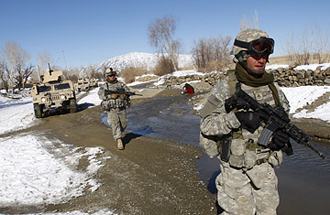The drawdown of U.S. troops from Afghanistan is seen as a political move to focus on domestic issues like jobs and the budget deficit as both parties gear up for next year’s election campaign. But the whittling down of ground troops with a war remaining to be fought may also reflect a major shift in the way we view success in overseas wars.
Hunting down Osama bin Laden was one of our key objectives in Afghanistan. But our ultimate success last month had less to do with the expenditure in Afghanistan of $426 billion and 1,540 American lives than with a focused intelligence effort combined with new hi-tech military capabilities. Both the intel operation and the hit were conducted elsewhere — the U.S., the Gulf of Oman, Pakistan.
By taking out a terrorist boss holed up in a luxury bunker in a crowded Pakistani city with very little collateral damage, the operation showed the possibilities of our own kind of asymmetric warfare — turning enemy leaders into ineffective fugitives in hiding. This kind of strategy would turn the tables on our enemies, by introducing a kind of asymmetric warfare our enemies can’t pursue against us.
Traditionally we have expended several orders of magnitude more in dollars than our enemy to secure vast perimeters in foreign lands and shore up entire nations with massive amounts of economic support in an effort to root out elusive enemy who attack, then evaporate like ghosts back into the general population. To add insult to injury, much of the billions we poured into Iraq, Afghanistan and Pakistan found their way into enemy coffers. This kind of brute-force approach to war not only drained our treasury and sapped our national will to pursue victory, but also made us responsible for much of the civilian body counts resulting from air strikes and ground battles. Such strategies may have been unavoidable ten, or even five, years ago, but now we have better options thanks to advances in drone and imaging technology and our rising sophistication in cultivating human assets on the ground.
So the drawdown of troops from Afghanistan shouldn’t be seen as a tacit admission of our inability to keep footing the bill for that and other wars against terrorism. It may be a shift toward a smarter, more cost-effective way to target the real culprits who mastermind attacks on our people and our interests.

